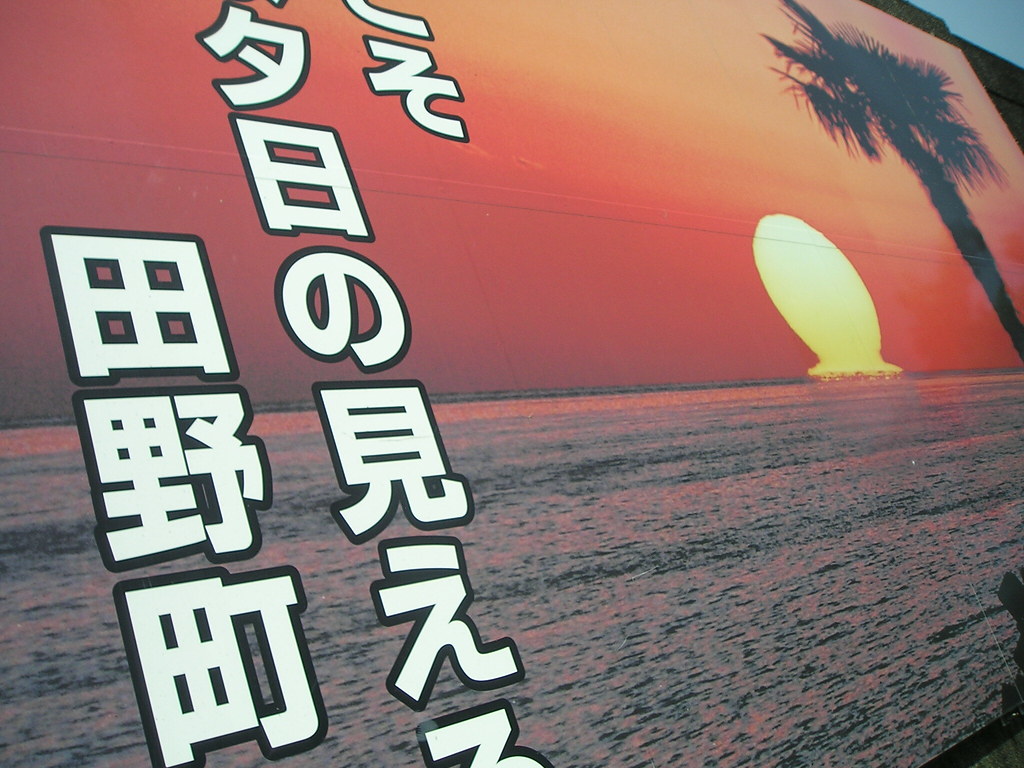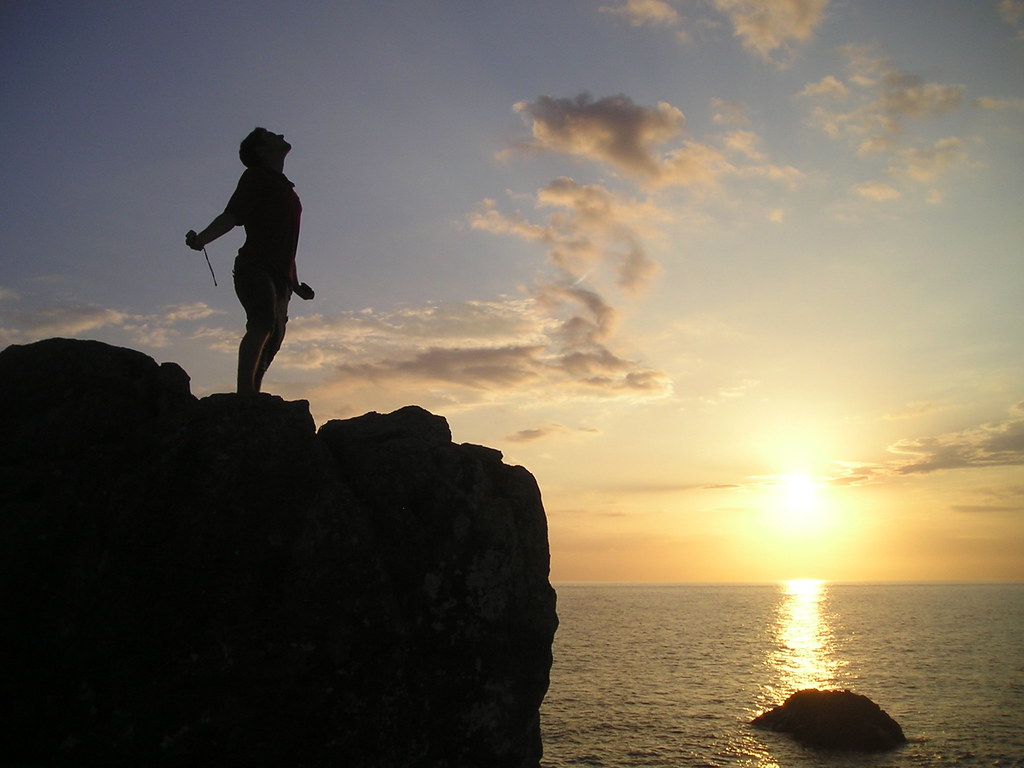Wednesday, 9 July 2008
 Different Japan: The Sun
Different Japan: The Sun
The Sun
What colour is the sun? Yellow? Orange? Somewhere in between? I don't feel we really have a 'set' colour for it in the West but they certainly do in Japan. Here's a hint:
 Yer... it's red of course. Just like the Japanese flag. Don't ever make the mistake of referring to the colour of the sun as anything other than red to a Japanese person. Especially a bunch of high school students who will tear you apart for your Western stupidity. The sun is red in Japan.
Yer... it's red of course. Just like the Japanese flag. Don't ever make the mistake of referring to the colour of the sun as anything other than red to a Japanese person. Especially a bunch of high school students who will tear you apart for your Western stupidity. The sun is red in Japan.The official name for Japan's flag is the Nisshoki (日章旗) or 'Sun Flag' but it is often called the Hinomaru (日の丸,) or 'Sun Disc'. It translates as that into English anyway but the kanji mean a few things. I suppose this is as good a time as any to explain my limited knowledge of them a bit. The first kanji is 日and this represents: the sun, sunshine, day and is the counter for days. It's not too difficult and it is a simple kanji that you will find in many other ones. However, like all kanji, it can be read in many ways such as 'hi' on it's own. This changes slightly if it is read with something else like 日本 which is the kanji for Japan... which reads as 'ni-hon'. Also, it is used much like 1st, 2nd 3rd and 4th are used for English dates. Today is the 9th so that is 九日or 'kokonoka'. It is read as 'ka' for these first few dates and 'nichi' in dates past the 10th. So next week will be 十六日 or 'ju (10) roku (6) nichi'.
 The kanji in the 'Sun Disc' consist of 日+の+丸. The first one is the sun and is read as 'hi'. The second one is not a kanji character but a Japanese hiragana character that always reads as 'no'. It is used to show possession in this particular case much like an apostrophe would be used in English. Therefore, the first two characters read as 'hino' and can be read as Sun's.... I guess. The last one has just one reading of 'mura' and can mean: circle, full (day/month), perfection and purity. Therefore, we have hi+no+maru which I guess can mean Sun's Circle, Full Sun or Sun's Purity.... maybe... I really don't know. I'm not sure where the 'disc' comes into it as everything I've read said 丸 just mean circle. However... there is another widely used kanji that means circle 円. This is also read as 'maru' when it is referring to a circle BUT it is also read as 'en' and is the Japanese kanji for Yen or ¥. I'm not sure why the 'y' is dropped in Japan. There used to be a hiragana character for 'ye' but it vanished after WW2 I think when the laguage was revised a bit.
The kanji in the 'Sun Disc' consist of 日+の+丸. The first one is the sun and is read as 'hi'. The second one is not a kanji character but a Japanese hiragana character that always reads as 'no'. It is used to show possession in this particular case much like an apostrophe would be used in English. Therefore, the first two characters read as 'hino' and can be read as Sun's.... I guess. The last one has just one reading of 'mura' and can mean: circle, full (day/month), perfection and purity. Therefore, we have hi+no+maru which I guess can mean Sun's Circle, Full Sun or Sun's Purity.... maybe... I really don't know. I'm not sure where the 'disc' comes into it as everything I've read said 丸 just mean circle. However... there is another widely used kanji that means circle 円. This is also read as 'maru' when it is referring to a circle BUT it is also read as 'en' and is the Japanese kanji for Yen or ¥. I'm not sure why the 'y' is dropped in Japan. There used to be a hiragana character for 'ye' but it vanished after WW2 I think when the laguage was revised a bit. Deary me... I'm blabbering on a little bit. Anyway, my main point was the use of 丸 instead of 円 in reference to disc or circle. It could be the case that they do actually represent different meanings of the shape. However, I was wondering (and like it to be so) if it was more the case that the other also contains the meanings of perfection and purity? I'd put a cheeky bet that this was the case but I'm also incredibly out my depth when I talk about kanji. That was really the point I was trying to reach with all that kanji muttering. I quite like the Japanese flag despite it occasionally being accused because of its associtation with WW2. I like it because its quite unique comapred to others in the world and it is very relevant to the history of the country's name.
Nevertheless, I have one more small mention to do with the sun. I've already mentioned in this post and others that the Japanese name for their country is Nihon*. Have you ever wondered why Japan is often referred to as the 'Land of the Rising Sun'? Well, I'm going to tell you anyway. There is no surprise that it is another reference to the kanji of 日本. I'm more used to reading the second kanji as 'book' because that is used more often in everyday life. However, it also means origin, source, base or root. So in English it can be read as 'Origin of the Sun'. This name and kanji were actually given by some Chinese bloke in the 7th century in reference to the fact that the sun rose in Japan first because it was further East. Personally, I find it all very cool. When I first came here I asked someone (4 years of Japanese study/1 year study abroad) what the kanji in the name meant. At first I was wondering why sun and book were together in the name. They weren't really interested for some reason. Although they mentioned that it also meant root and so I asked again if that was all linked to the rising sun thing. Surprisngly... they didn't really care. It confused me because I wondered how someone could have an interest in the country and language yet not wonder about the history behind it? It's the most interesting thing about.
 I only intended to mention the bit about the colour of the sun being red but it evolved into a bit of a messy and possibly incorrect post. There is one more thing that makes me laugh: Japanese women are terrified of the sun. They'll do anything to protect themselves from it such as carrying umbrellas, wearing white silk gloves up to their elbows and wearing the most ridiculous shaped hats I've ever seen. I think they're scared that they'll get a bit of a tan and look Chinese...
I only intended to mention the bit about the colour of the sun being red but it evolved into a bit of a messy and possibly incorrect post. There is one more thing that makes me laugh: Japanese women are terrified of the sun. They'll do anything to protect themselves from it such as carrying umbrellas, wearing white silk gloves up to their elbows and wearing the most ridiculous shaped hats I've ever seen. I think they're scared that they'll get a bit of a tan and look Chinese...Also, you do get some cracking sunsets here. The picture at the top right is the 'Daruma sunset' that occurs in my prefecture in the Winter. Ocean currents/change in temperature give the illusion of the sun with a neck as the light is refracted. Even tonight the sky was looking excellent from behind the mountains. I've only witnessed one Japanese sunrise and that was last week when I got up early to watch the football. In the summer it rises at about 4am but it gets dark at about 7pm. I kind of miss the lingering sun and the late nights of a Scottish summer... and there's never any of this bloody humidity back home.
*I recently read (in my book about the British Empire) the reason why the rest of world calls it Japan. The Portuguese traders somehow got the name of Japan from one or two areas of China who use the same kanji but read it differently. They referred to the country as Jipangu, Cipangu, Zipangu and so forth. Here is a great map I found on wikipedia that shows one of these names. It was made in 1492 and completely misses out the Americas because Columbus was just discovering them.
Subscribe to:
Post Comments (Atom)




0 comments:
Post a Comment